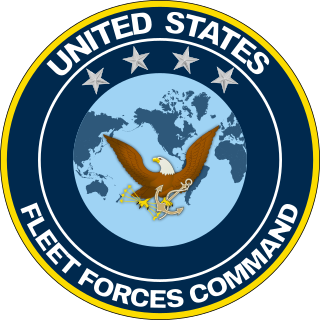
The United States Fleet Forces Command (USFF) is a service component command of the United States Navy that provides naval forces to a wide variety of U.S. forces. The naval resources may be allocated to Combatant Commanders such as United States Northern Command (USNORTHCOM) under the authority of the Secretary of Defense. Originally formed as United States Atlantic Fleet (USLANTFLT) in 1906, it has been an integral part of the defense of the United States of America since the early 20th century. In 2002, the Fleet comprised over 118,000 Navy and Marine Corps personnel serving on 186 ships and in 1,300 aircraft, with an area of responsibility ranging over most of the Atlantic Ocean from the North Pole to the South Pole, the Caribbean Sea, Gulf of Mexico, and the waters of the Pacific Ocean along the coasts of Central and South America.

The United States Third Fleet is one of the numbered fleets in the United States Navy. Third Fleet's area of responsibility includes approximately fifty million square miles of the eastern and northern Pacific Ocean areas including the Bering Sea, Alaska, the Aleutian Islands, and a sector of the Arctic. Major oil and trade sea lines of communication within this area are critically important to the economic health of the United States and friendly nations throughout the Pacific Rim region.

The Fifth Fleet is a numbered fleet of the United States Navy. It has been responsible for naval forces in the Persian Gulf, Red Sea, Arabian Sea, and parts of the Indian Ocean since 1995 after a 48-year hiatus. It shares a commander and headquarters with U.S. Naval Forces Central Command (NAVCENT) in Bahrain. Fifth Fleet/NAVCENT is a component command of, and reports to, U.S. Central Command (CENTCOM).

The Naval War College is the staff college and "Home of Thought" for the United States Navy at Naval Station Newport in Newport, Rhode Island. The NWC educates and develops leaders, supports defining the future Navy and associated roles and missions, supports combat readiness, and strengthens global maritime partnerships.
The structure of the United States Navy consists of four main bodies: the Office of the Secretary of the Navy, the Office of the Chief of Naval Operations, the operating forces, and the Shore Establishment.
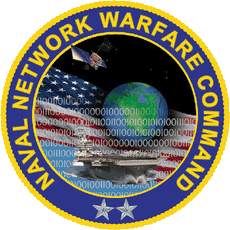
The Naval Network Warfare Command (NAVNETWARCOM) is the United States Navy's information operations, intelligence, networks, and space unit. Naval Network Warfare Command's mission is to execute, under Commander TENTH Fleet Operational Control, tactical-level command and control of Navy Networks and to leverage Joint Space Capabilities for Navy and Joint Operations.

The Commander, Naval Surface Force, Atlantic (COMNAVSURFLANT) is a post within the United States Fleet Forces Command. As Naval Surface Force Atlantic, it is a military formation, and the organization is often known as SURFLANT. Its headquarters are at Naval Station Norfolk in Norfolk, Virginia. The current commander is Rear Admiral Brendan R. McLane. COMNAVSURFLANT supervises all surface ships based on the Eastern United States and Gulf Coast of the United States, as well as ships forward deployed to Naval Station Rota, Spain.
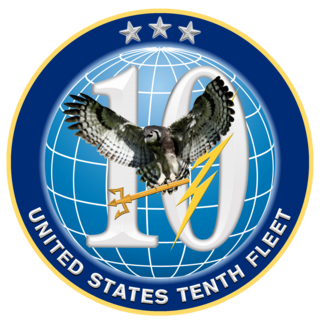
The U.S. Tenth Fleet is a functional formation and a numbered fleet in the United States Navy. It was first created as an anti-submarine warfare coordinating organization during the Battle of the Atlantic in the Second World War. It was reactivated as a force provider for Fleet Cyber Command on 29 January 2010. U.S. Tenth Fleet serves as the numbered fleet for U.S. Fleet Cyber Command and exercises operational control of assigned naval forces to coordinate with other naval, coalition and Joint Task Forces to execute the full spectrum of cyber, electronic warfare, information operations, and signal intelligence capabilities and missions across the cyber, electromagnetic, and space domains.
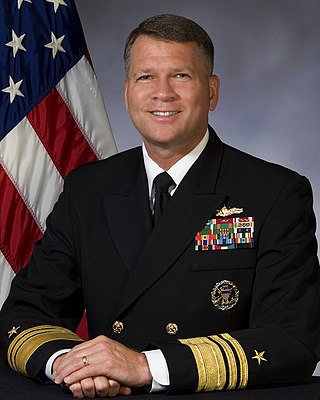
David John "Jack" Dorsett is a corporate vice president for cyber and C4 at Northrop Grumman, and a retired vice admiral of the U.S. Navy. He was the first Deputy Chief of Naval Operations for Information Dominance and 63rd Director of Naval Intelligence. He served as the Director of Intelligence, Joint Chiefs of Staff from 2005 to 2008 prior to assuming his position on the Chief of Naval Operations staff.

The Commander, Naval Air Force Atlantic is the aviation Type Commander (TYCOM) for the United States Naval aviation units operating primarily in the Atlantic under United States Fleet Forces Command. Type Commanders are in administrative control (ADCON), and in some cases operational control (OPCON) of certain types of assets assigned to the Pacific and Atlantic Fleets. AIRLANT is responsible for the material readiness, administration, training, and inspection of units/squadrons under their command, and for providing operationally ready air squadrons and aircraft carriers to the fleet.

U.S. Navy type commands perform administrative, personnel, and operational training functions in the United States Navy for a "type" of weapon system within a fleet organization.
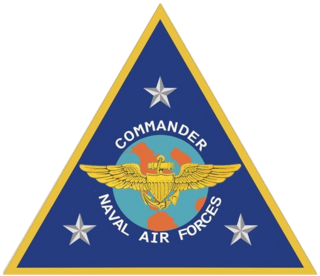
The Commander, Naval Air Forces is the aviation Type Commander (TYCOM) for all United States Navy naval aviation units. Type Commanders are in Administrative Control (ADCON), and in some cases Operational Control (OPCON) of certain types of assets assigned to the Pacific and Atlantic Fleets. AIRFOR is responsible for the materiel readiness, administration, training, and inspection of units/squadrons under their command, and for providing operationally ready air squadrons and aircraft carriers to the fleet.
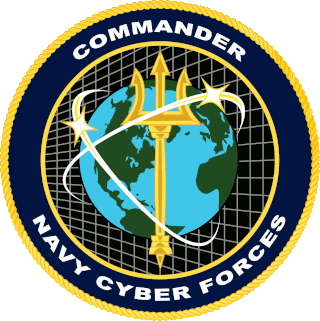
The Navy Cyber Forces (CYBERFOR) was the type command for the U.S. Navy's global cyber workforce. The headquarters was located at 115 Lake View Parkway in Suffolk, Virginia. CYBERFOR provided forces and equipment in cryptology/signals intelligence, cyber, electronic warfare, information operations, intelligence, networks, and space. Navy Cyber Forces was an operational component of the U.S. Navy Information Dominance Corps. CYBERFOR has been absorbed into the Naval Information Forces command.

The U.S. Navy Information Warfare Community (IWC) leads and manages a cadre of officers, enlisted, and civilian professionals who possess extensive skills in information-intensive fields. This corps works in information, intelligence, counterintelligence, human-derived information, networks, space, and oceanographic disciplines to support US Navy, Joint and national war fighting requirements. The IWC is part of a U.S. Navy initiative to merge intelligence with command, control, communications, and computers.

Ted N. "Twig" Branch retired as a vice admiral in the United States Navy on 1 October 2016, after serving the last three years of his 37-year career as the Deputy Chief of Naval Operations for information warfare. In that capacity, he was the resource sponsor for the N2N6 portfolio which includes program investments for assured command and control, battlespace awareness, and integrated fires. He was the Navy's Chief Information Officer, the Director of Navy Cybersecurity, the leader of the Information Warfare Community, and the Director of Naval Intelligence. Branch was questioned by the Department of Justice regarding the Glenn Defense Marine Asia investigation in November 2013 and his access to classified information was suspended by the Secretary of the Navy. After a three-year investigation, Branch was cleared of all charges.

Christopher Watson Grady is a United States Navy admiral who is currently serving as the 12th vice chairman of the Joint Chiefs of Staff since December 20, 2021.

Kelly A. Aeschbach is a vice admiral in the United States Navy who currently serves as the commander of U.S. Naval Information Forces (NAVIFOR). Before that, she served as Director of the National Maritime Intelligence-Integration Office and Commander of the Office of Naval Intelligence. and prior to that as Deputy Director of Intelligence for United States Forces – Afghanistan.

Brian Bentley Brown is a retired United States Navy vice admiral and navigator who last served as commander of the U.S. Naval Information Forces from June 2018 to May 2021. Brian became the second naval officer to assume the NAVIFOR office since it was established. In 1990, he served as a surface warfare officer and was subsequently transferred to the navy's operational arm oceanography command. He was also appointed as the chief of the Navy Space Cadre. As a navigator and administrator, he served aboard aircraft carriers, including USS La Salle and USS Theodore Roosevelt.

Daryl Lane Caudle is a United States Navy admiral who is the 35th commander of United States Fleet Forces Command since December 7, 2021. He most recently served as commander of Naval Submarine Forces (COMSUBFOR), Commander, Submarine Force Atlantic (COMSUBLANT) and Commander, Allied Submarine Command (ASC). As COMSUBFOR, he was the undersea domain lead, and is responsible for the submarine force's strategic vision. As COMSUBLANT, he commanded all Atlantic-based U.S. submarines, their crews and supporting shore activities. These responsibilities also include duties as commander, Task Force (CTF) 114, CTF 88, and CTF 46. As commander, Allied Submarine Command, he was the principal undersea warfare advisor to all North Atlantic Treaty Organization (NATO) strategic commanders.























